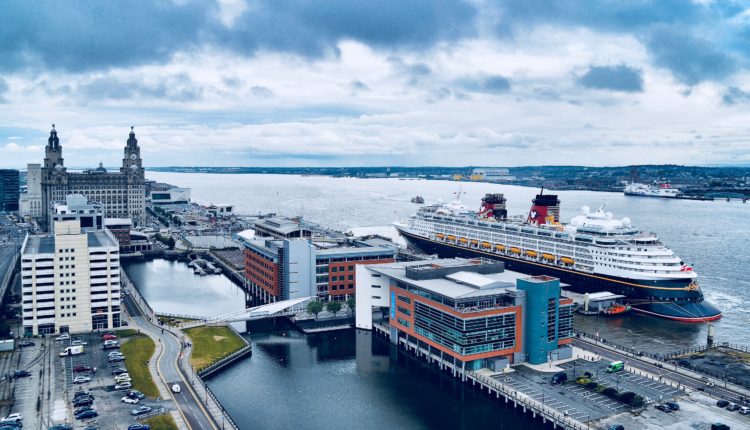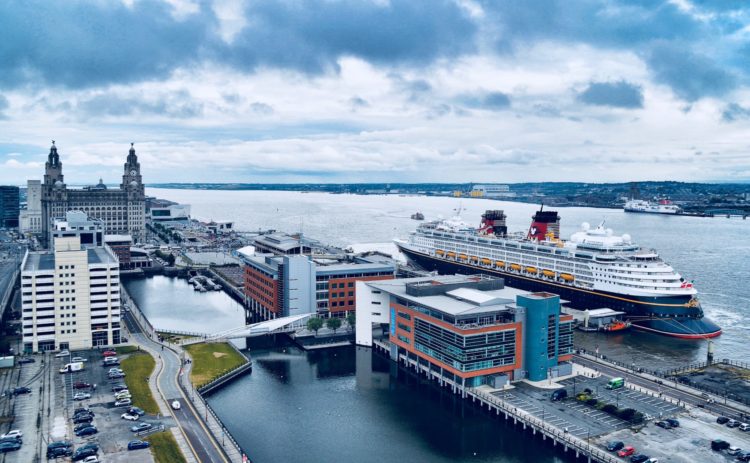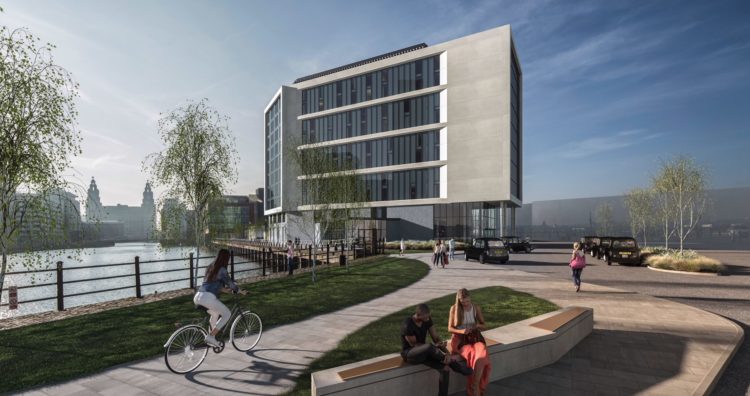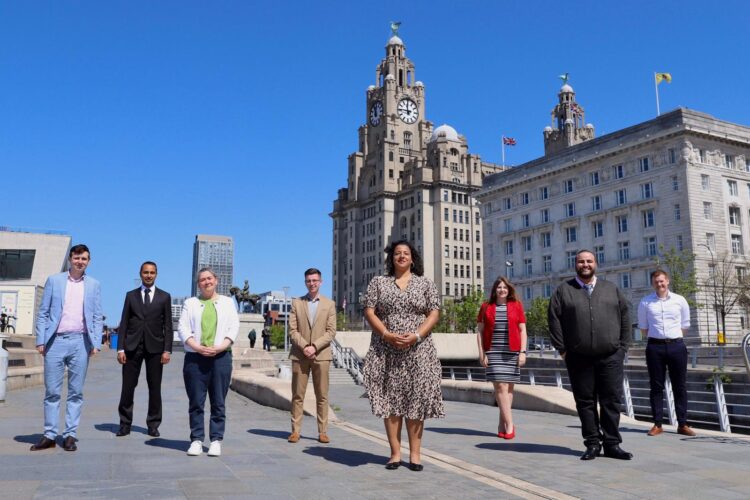
In a special report, Tony McDonough asks whether plans for Liverpool’s new £50m Cruise Terminal will have to be revised amid the rapidly-changing economics of a post-pandemic world

On Monday newly-built cruise ship, Viking Venus, berthed at Liverpool Cruise Terminal – the first cruise call at the facility in 14 months.
And there have been plans in the pipeline for a number of years to build a bigger, more permanent terminal with the capacity to handle the world’s biggest vessels. But the COVID-19 pandemic has thrown a cloud of uncertainty over the £50m project.
Just over a year ago, the team at Cruise Liverpool were getting ready for what would be the terminal’s busiest year since it was officially opened by the Duke of Kent in 2007. More than 100 vessels were due to call in spring, summer and into the autumn.
Then COVID-19 turned the world upside down and the £100bn global cruise industry, supporting 2m jobs worldwide, ground to a halt. For every day the world’s cruise ships are laid up, 2,500 jobs are lost.
However, with the COVID vaccine being rolled out across the world, cruise ships are setting sail once again. But with reduced numbers of passengers due to social distancing, the industry is not what it was pre-pandemic and there is a question mark as to whether it ever will be again.
Liverpool Cruise Terminal is expecting around 80 cruise calls this year. This is welcome news for the terminal and the wider city centre economy but, with fewer ships carrying fewer passengers, the estimated annual revenues for the city are likely to be significantly less than the £12m expected pre-pandemic.
A report published late last year, written by Liverpool City Council’s head of assets, Angie Redhead (also head of Cruise Liverpool), estimated the terminal would lose around £1.1m due to COVID-19. The city council usually generates around £2.5m in annual income from the facility.
So although the return this year of cruise ships is good news for the city, the change in the economics of the cruise sector raises questions about the project to build a new terminal on the waterfront. The city council has told LBN it remains committed to the project.
In a statement it said: “Given the impact of the COVID-19 pandemic, the city council is currently assessing timescales for taking the new Cruise Liner Terminal forward to the next stage. Despite the global setback to the cruise industry, the council remains committed to the scheme and the return of passenger shipping to its World Heritage waterfront.”
The current terminal is a floating structure located off Princes Dock and was only ever intended to be a temporary facility. It comprises a floating landing stage and small terminal building.
It cost around £10m to create and was funded by money from the European Objective One programme. Because of this funding, state aid rules meant cruise ships were not allowed to start or end cruises at Liverpool. It was merely a stop-off point for passengers.


However, intense lobbying of the Government by the city council secured a relaxation of those rules, allowing cruise companies to offer cruises from Liverpool for the first time since the terminal opened. This was despite the strong objections of Southampton, still the main port for the UK cruise industry.
This was a game-changer for Liverpool, significantly increasing the number of vessels coming up the Mersey and boosting the local economy, especially businesses in the hospitality sector. And it was the subsequent momentum which led to the plan to build a new terminal.
In the same report by Angie Redhead last November, it was stated that a combination of COVID-19 and Brexit would push back the timetable for the new facility by a year. It was due to be ready for the 2022 cruise season and that was pushed back to 2023.
The report said work could not go ahead until the authority had secured a Harbour Revision Order. A HRO comes from the International Marine Organisation via the Government and it needs to be sanctioned by Parliament.
The HRO was secured in April this year but, with the economics of the cruise industry significantly changed, will a new business case for the terminal, which would also receive funding from the Liverpool City Region Combined Authority, now have to be presented?
Current plans would see a 100,000 sq ft terminal building constructed on two floors; the ground floor being the baggage hall and entrance lobby. The first floor will include the passenger lounge, check-in area and cafe.
It will be connected by a pedestrian and vehicular link-span bridge to the existing cruise ship landing stage. The plans also include a 200-bed hotel at Princes Dock Liverpool Waters, close to the terminal building.
Once completed, the terminal would replace the existing facility and will enable the world’s largest cruise ships (up to 3,600 passengers) to embark and disembark at Liverpool. It is expected to directly create more than 500 new jobs.
Work includes dismantling the redundant and derelict jetty and construction of the new terminal on a new jetty in the River Mersey. Construction of a new Isle of Man ferry terminal at the far end of the main terminal has already started.
And while there are question marks over the economic case for the new terminal, there is another dimension which may now come into play: the environmental impact of the cruise sector.
Under previous Mayor Joe Anderson, himself a former seaman, the city council pursued a keen economic development strategy that heavily favoured attracting major investment into the city.
Mr Anderson can claim credit for projects such as the £2bn Knowledge Quarter and was a major supporter of Everton’s proposed £500m docklands stadium. And he was a big cheerleader for the proposed terminal.
Now a new Mayor is in office. Joanne Anderson and her relatively young cabinet are promising a different way of doing things. While economic growth is sure to be a key part of the agenda for Ms Anderson and her team, there is likely to be much more of a focus on what they call “community wealth building”.
“Our values are expressed in what we do and what we say,” the new Mayor told the Guardian newspaper in an interview last week. “We have committed socialists up here in the north in key positions.”
It will also mean a bigger focus on the environment. The council declared a climate emergency in 2019 and the new Cabinet Member for Climate Change and Environment, Cllr Dan Barrington, will be keen to take that commitment out of the abstract and translate it into real action.
This could put the Cruise Terminal project in a different light. Cruise ships may be many things, but good for the environment they are not. They are floating cities and it is estimated a cruise ship passenger will burn through the same amount of carbon in seven days than they would in 18 days on land.


Marine fuel, especially the bunker fuel used by ocean-going vessels, is pretty toxic stuff. It is a tar-like sludge that contains 3,500 times more sulphur than the diesel used for cars. Cruise ships also generate huge amounts of waste.
That said, it would be a brave politician in Liverpool to stand up and say we don’t want cruise ships in the Mersey. There is a huge emotional connection between the people of Merseyside and the maritime sector.
In the late 19th and early-mid 20th century, the world’s biggest cruise vessel were regular sights on the Liverpool’s quayside. Their absence was keenly felt and their return in 2007 was enthusiastically welcomed. Crowds still gather to see the ships off with music and fireworks. You don’t see that in Southampton.
In 2015, Cunard brought Queen Mary, Queen Elizabeth and Queen Victoria to the Mersey as part of its 175th anniversary celebrations. The Three Queens event brought more than 1m people to both banks of the river and the sight of those three magnificent vessels, with the Red Arrows overhead, will live long in the memory.
So it is likely we will continue to see cruise ships coming to the Mersey for many years to come but it remains to be seen whether plans for the new Cruise Terminal will have to be revised in the light of a rapidly changing world.
